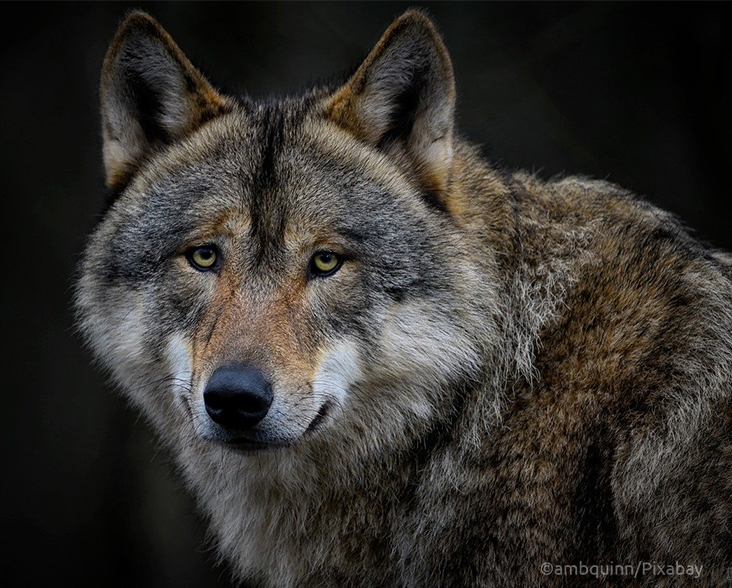Species Data
Class: Mammalia
Order: Carnivora
Family: Canidae
Scientific Name: Canis lupus
IUCN Red List status: Least Concern
Description
A highly adaptable species capable of thriving in a variety of habitats – from the frozen High Arctic to the harsh deserts of Arabia – the Grey Wolf differs greatly in size and appearance throughout its range. Adults may weigh between 18 and 80 kg, with a coat that is usually grizzled grey but can be black, brown, reddish, or (particularly in polar regions) white. Wolves began to be domesticated by humans at least 15,000 years ago, leading to today’s domestic dogs, and while man’s best friend evolved to become a fixture in our homes, wild wolves have continued to play a prominent role in human history, mythology and folklore.
Behaviour
Grey Wolves usually live in packs comprised of an alpha male, an alpha female and their offspring. A typical pack will include six to 10 individuals, but pack size can range from as few as two wolves to as many as two dozen. The pack is held together by strong social bonds and a strict dominance hierarchy, imposed from the top by the alphas who are usually the only ones to breed. Breeding occurs between February and April, and a litter of usually five or six pups is born in the spring. All adult pack members help care for the pups, who will start participating in hunts at six months old and reach adult size at around one year old.
A pack’s territory can range in size from 80 to 3,000 km2. Howling and scent marking help pack members to communicate with each other, while also warning rival packs not to intrude. The coordination and sheer numbers of a wolf pack, combined with speed, stamina, formidable jaws and keen senses of smell, hearing and vision, make the Grey Wolf a highly effective predator capable of bringing down very large prey. Hooved mammals such as deer, moose, bison, antelope and muskox are the main sources of prey, but where these aren’t available wolves have adapted to hunt smaller mammals and follow an eclectic assortment of diets that include birds, fish, lizards, snakes, clams and even fruit.


Habitat
The Grey Wolf was once the world’s most widely distributed mammal, and despite having lost around a third of its historical range, it remains present in a vast swathe of the Northern Hemisphere. Across its current range in Europe, Asia and North America, it is found in habitats as varied as temperate forests, mountains, tundra, taiga, grasslands and deserts. Although wolves occur mainly in wilderness and remote areas, they are also found in human-dominated landscapes where there is sufficient prey base and human-caused mortality is low.
Threats and Conservation
The global Grey Wolf population is stable and estimated to number some 200-250,000 individuals. Numbers are increasing in some parts of the wolf’s range, like the western United States and Europe, but these increases are likely to be offset by localised declines elsewhere. Small and isolated subpopulations, like those in Scandinavia, are especially at risk. Humans were responsible for driving wolves to extinction in the United Kingdom, Ireland, Japan and other parts of the species’ historical range, and we remain the largest threat to wolves today.
Livestock are still a significant source of conflict between wolves and humans, exacerbated by human hunting of wild prey animals and an exaggerated concern from the public concerning the threat and danger of wolves. In areas with the highest density of human activities, habitat loss and fragmentation threaten the long-term viability of resident wolf populations. Although deliberate persecution of wolves – poaching, hunting, trapping and poisoning – is still ongoing, the outlook for the species has improved markedly since the 1970s thanks to a combination of legal protection, land-use changes, increasing prey populations, and a shift in the human population from rural areas to cities.
In Armenia, WLT partner FPWC manages the Caucasus Wildlife Refuge, providing over 30,000 ha of protected habitat for the Grey Wolf, Eurasian Lynx, Caucasian Leopard and Syrian Brown Bear, as well as prey species like the Armenian Mouflon and Bezoar Goat. The mountainous steppe, grasslands and Juniper forests here provide ample hunting and foraging grounds, while FPWC rangers patrol for poachers and engage with local communities to reduce human-wildlife conflict. A new project led by WLT and FPWC aims to plant 700,000 native trees here between 2023 and 2027, restoring 300 ha of degraded habitat along a migratory route for these large mammals.
